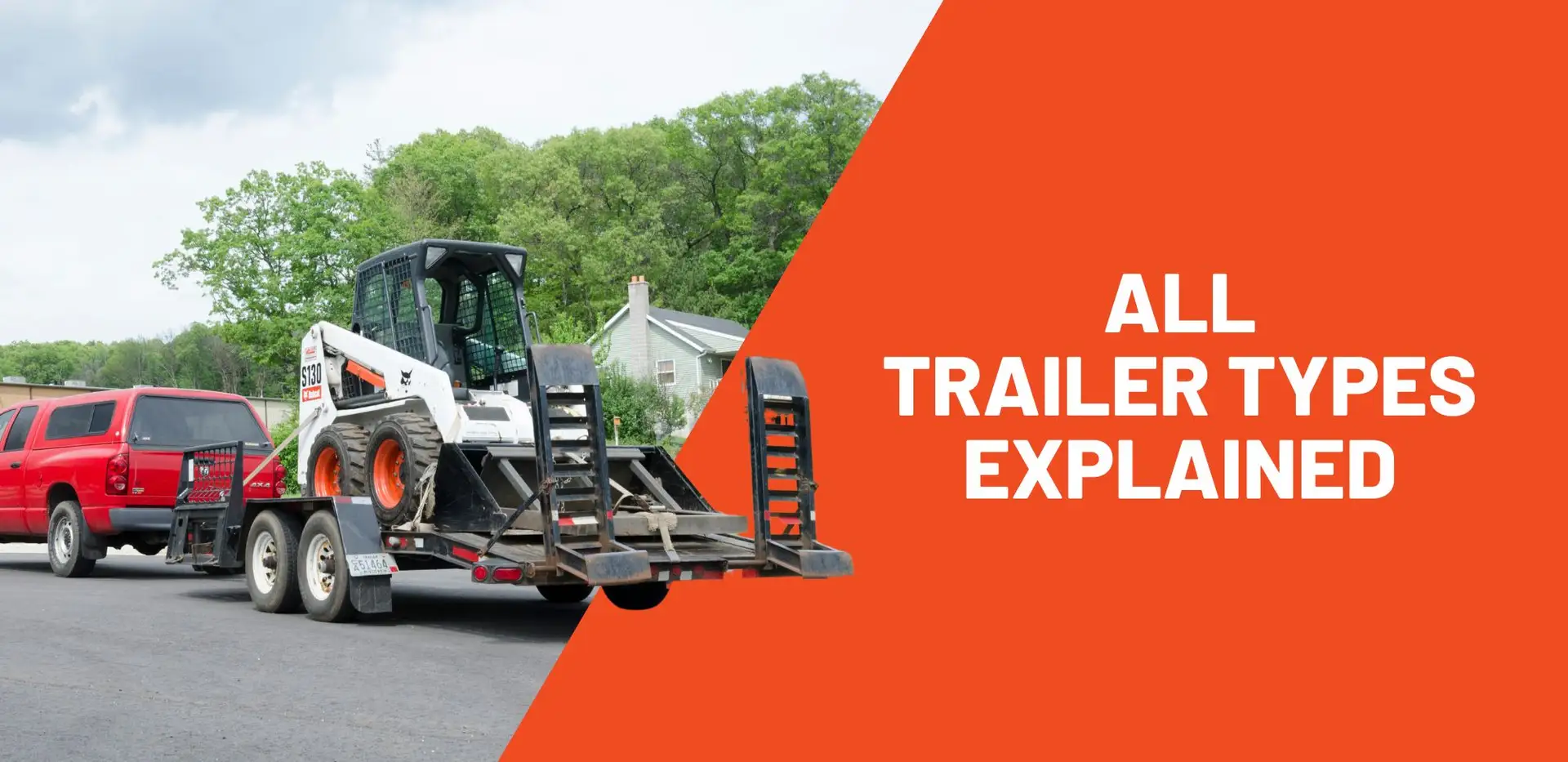
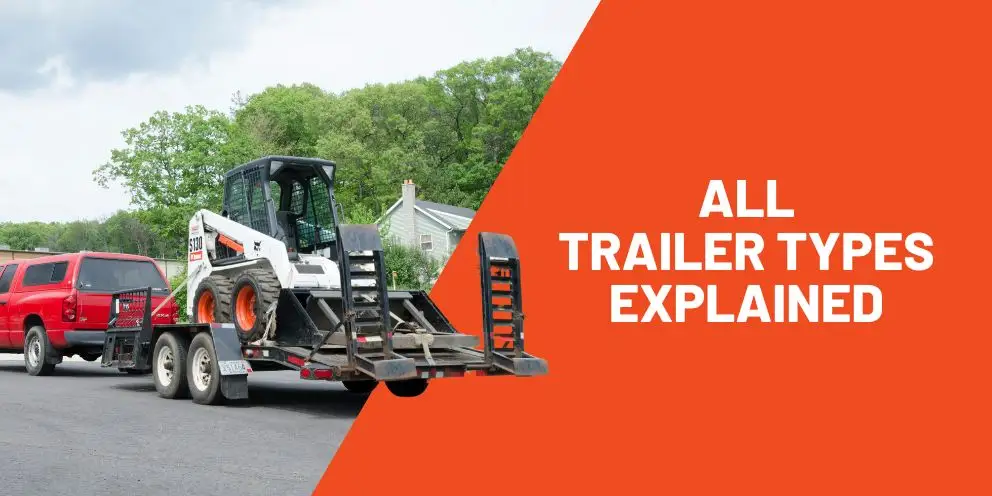
Types of Trailers: A Comprehensive Guide
Trailers are everywhere. Roads, parking lots, campsites, backyards, cornfields, boat docks – wherever you are, you can probably find a trailer nearby. However, as you’ve likely already noticed, not all trailers are the same, and the differences between them can range from discreet to dramatic.
In this blog, we will take a look at the different types of trailers and what each of them has to offer in terms of purpose, features, and size. Whether you are hoping to become the proud owner of a trailer yourself or just want to brush up on your trailer trivia skills, this guide can help.
Trailer Types Comparison Chart
| Trailer Type |
General Purpose |
Distinguishing Feature |
Tow Vehicle Options |
Number of Axles |
Weight Range (GVWR) |
Average Length |
| 5th wheel trailer | Camping, RVing, + | Pin-box-type coupler for connecting to a 5th wheel hitch | Large trucks | 1 to 4 | 7,500 to 16,000 lbs. | 25' to 50' |
| A-frame trailer | Camping or hauling | A-shaped body or tongue portion of the frame | Trucks or SUVs | 1 to 2 | 2,500 to 3,600 lbs. | 8' to 24' |
| ATV trailer | Hauling yard supplies or outdoor gear | Off-road, wagon-style design | ATVs or UTVs | 1 to 2 | 125 to 1,500 lbs. | 5' to 10' |
| Boat trailer | Hauling a watercraft | Rollers and bars to securely hold boat | Cars, vans, trucks, SUVs, + | 1 to 3 | 900 to 34,400 lbs. | 16' to 30' |
| Bumper pull trailer | Camping, RVing, hauling, + | Tongue with coupler vs. gooseneck or 5th wheel coupler | Cars, vans, trucks, SUVs, + | 1 to 4 | 125 to 20,000 lbs. | 5' to 40' |
| Canoe / kayak trailer | Hauling canoes, kayaks, paddleboards | Adjustable bars for multiple canoes / kayaks | Cars, vans, trucks, SUVs, + | 1 | 200 to 800 lbs. | 10' to 17' |
| Car trailer | Hauling automotive vehicles (e.g. cars) | Flat trailer bed with ramp(s) at the back | Large trucks | 1 to 3 | 1,000 to 15,000 lbs. | 14' to 24' |
| Cargo trailer | Hauling cargo, gear, supplies, + | Often walls and roof to protect cargo | Cars, vans, trucks, SUVs, + | 1 to 3 | 2,700 to 7,000 lbs. | 8' to 24' |
| Construction trailer | Office space for a construction site | Portable, temperature-controlled, secure, customizable | Large trucks | 1 to 3 | 3,000 to 10,000 lbs. | 16' to 64' |
| Dump trailer | Hauling materials (e.g. dirt, gravel, woodchips, etc.) | Open box that pivots back to dump materials | Large trucks | 1 to 4 | 3,000 to 30,000 lbs. | 8' to 30' |
| Enclosed trailer | Hauling with extra protection | Fully enclosed body with walls and roof | Cars, vans, trucks, SUVs, + | 1 to 2 | 2,000 to 10,000 lbs. | 8' to 32' |
| Equipment trailer | Hauling equipment | Flat bed, ramps | Trucks or SUVs | 1 to 3 | 1,000 to 10,000 lbs. | 16' to 32' |
| Flatbed trailer | Hauling bulky equipment or supplies | Open bed only, usually with no walls | Trucks or SUVs | 1 to 3 | 2,900 to 26,000 lbs. | 48' to 53' |
| Food concession trailer | Mobile kitchen and / or food stand | Serving window to pass through food, drink and money | Trucks or SUVs | 1 to 2 | 5,500 to 8,000 lbs. | 6' to 32' |
| Gooseneck trailer | Hauling livestock, equipment, materials, + | Gooseneck-style coupler | Large trucks | 2 to 3 | 15,900 to 36,000 lbs. | 20' to 40' |
| Horse trailer | Hauling horses or other large livestock | Enclosed body with walls and roof, windows, partisions for mult horses, better suspension | SUVs, pickup trucks, heavy-duty trucks (depends on size) | 2 to 3 | 5,000 to 9,000 lbs. | 16' to 49' |
| Jet ski trailer | Hauling one or two personal watercraft (i.e. jet skis) | Rollers and bars to support PWC, compact size | Cars, vans, trucks, SUVs, + | 1 to 2 | 800 to 3,000 lbs. | 12' to 15' |
| Landscape trailer | Hauling tools and materials for landscaping | Tall sides, ramp for unloading | Cars, vans, trucks, SUVs, + | 1 to 2 | 1,000 to 3,000 lbs. | 8' to 24' |
| Livestock trailer | Hauling livestock | Gaps / slits in walls for increased ventilation, secure gates | SUVs, pickup trucks, heavy-duty trucks (depends on size) | 2 to 3 | 9,400 to 24,000 lbs. | 14' to 34' |
| Motorcycle trailer | Hauling one or two motorcycles | Trays or brackets to hold motorcycle wheels | Cars, vans, trucks, SUVs, + | 1 to 2 | 1,300 to 3,500 lbs. | 8' to 12' |
| Open trailer | Hauling cargo, materials, supplies, + | No roof and low or no walls | Cars, vans, trucks, SUVs, + | 1 to 2 | 1,000 to 10,000 lbs. | 8' to 32' |
| Popup trailer | Camping for small group | Popup / foldout living space | Cars, vans, trucks, SUVs, + | 1 | 2,700 to 4,000 lbs. | 8' to 24' |
| Recreational vehicle trailer | RVing or hauling vehicles for recreation | Portable living space | Cars, vans, trucks, SUVs, + | 1 to 4 | 1,900 to 22,500 lbs. | 15' to 48' |
| Single-axle trailer | Hauling, camping, + | One trailer axle | Cars, vans, trucks, SUVs, + | 1 | 1,000 to 4,500 lbs. | 5' to 20' |
| Tandem axle trailer | Hauling, camping, + | Two trailer axles | Cars, vans, trucks, SUVs, + | 2 | 3,000 to 30,000 lbs. | 12' to 24' |
| Teardrop trailer | Camping for one or two people | Compact, teardrop-shaped body | Cars, vans, trucks, SUVs, + | 1 | 2,000 to 4,000 lbs. | 5' to 12' |
| Toy hauler | Camping, RVing, + | Living space and a garage for recreational vehicles | Large trucks | 2 to 3 | 14,700 to 22,500 lbs. | 15' to 48' |
| Travel trailer | Camping, RVing, + | Portable living space | Trucks or SUVs | 1 to 2 | 1,900 to 10,500 lbs. | 15' to 40' |
| Tri-axle trailer | Hauling, camping, + | Three trailer axles | Pickup trucks, semi trucks | 3 | 10,000 to 30,000 lbs. | 20' to 53' |
| Utility trailer | Hauling cargo, materials, supplies, + | Flat deck, ramp | Cars, vans, trucks, SUVs, + | 1 to 2 | 1,000 to 10,000 lbs. | 8' to 22' |
Trailer Types Comparison Chart
| Trailer Type |
Trailer Diagram |
General Purpose |
Distinguishing Feature |
Tow Vehicle Options |
Number of Axles |
Weight Range (GVWR) |
Average Length |
| 5th wheel trailer | Camping, RVing, + | Pin-box-type coupler for connecting to a 5th wheel hitch | Large trucks | 1 to 4 | 7,500 to 16,000 lbs. | 25' to 50' | |
| A-frame trailer | Camping or hauling | A-shaped body or tongue portion of the frame | Trucks or SUVs | 1 to 2 | 2,500 to 3,600 lbs. | 8' to 24' | |
| ATV trailer | Hauling yard supplies or outdoor gear | Off-road, wagon-style design | ATVs or UTVs | 1 to 2 | 125 to 1,500 lbs. | 5' to 10' | |
| Boat trailer | Hauling a watercraft | Rollers and bars to securely hold boat | Cars, vans, trucks, SUVs, + | 1 to 3 | 900 to 34,400 lbs. | 16' to 30' | |
| Bumper pull trailer | Camping, RVing, hauling, + | Tongue with coupler vs. gooseneck or 5th wheel coupler | Cars, vans, trucks, SUVs, + | 1 to 4 | 125 to 20,000 lbs. | 5' to 40' | |
| Canoe / kayak trailer | Hauling canoes, kayaks, paddleboards | Adjustable bars for multiple canoes / kayaks | Cars, vans, trucks, SUVs, + | 1 | 200 to 800 lbs. | 10' to 17' | |
| Car trailer | Hauling automotive vehicles (e.g. cars) | Flat trailer bed with ramp(s) at the back | Large trucks | 1 to 3 | 1,000 to 15,000 lbs. | 14' to 24' | |
| Cargo trailer | Hauling cargo, gear, supplies, + | Often walls and roof to protect cargo | Cars, vans, trucks, SUVs, + | 1 to 3 | 2,700 to 7,000 lbs. | 8' to 24' | |
| Construction trailer | Office space for a construction site | Portable, temperature-controlled, secure, customizable | Large trucks | 1 to 3 | 3,000 to 10,000 lbs. | 16' to 64' | |
| Dump trailer | Hauling materials (e.g. dirt, gravel, woodchips, etc.) | Open box that pivots back to dump materials | Large trucks | 1 to 4 | 3,000 to 30,000 lbs. | 8' to 30' | |
| Enclosed trailer | Hauling with extra protection | Fully enclosed body with walls and roof | Cars, vans, trucks, SUVs, + | 1 to 2 | 2,000 to 10,000 lbs. | 8' to 32' | |
| Equipment trailer | Hauling equipment | Flat bed, ramps | Trucks or SUVs | 1 to 3 | 1,000 to 10,000 lbs. | 16' to 32' | |
| Flatbed trailer | Hauling bulky equipment or supplies | Open bed only, usually with no walls | Trucks or SUVs | 1 to 3 | 2,900 to 26,000 lbs. | 48' to 53' | |
| Food concession trailer | Mobile kitchen and / or food stand | Serving window to pass through food, drink and money | Trucks or SUVs | 1 to 2 | 5,500 to 8,000 lbs. | 6' to 32' | |
| Full trailer | Hauling, usually farm or commercial | Axles at both ends for standalone support | Large trucks or tractors | 2 to 4 | 26,000 to 33,000 lbs. | 10' to 26' | |
| Gooseneck trailer | Hauling livestock, equipment, materials, + | Gooseneck-style coupler | Large trucks | 2 to 3 | 15,900 to 36,000 lbs. | 20' to 40' | |
| Gravity box | Holding and unloading crops or fertilizers | Slanted walls and door near the bottom for easy unloading | Large trucks or tractors | 2 | 1,750 to 7,050 lbs. | 17' to 25' | |
| Horse trailer | Hauling horses or other large livestock | Enclosed body with walls and roof, windows, partisions for mult horses, better suspension | SUVs, pickup trucks, heavy-duty trucks (depends on size) | 2 to 3 | 5,000 to 9,000 lbs. | 16' to 49' | |
| Jet ski trailer | Hauling one or two personal watercraft (i.e. jet skis) | Rollers and bars to support PWC, compact size | Cars, vans, trucks, SUVs, + | 1 to 2 | 800 to 3,000 lbs. | 12' to 15' | |
| Landscape trailer | Hauling tools and materials for landscaping | Tall sides, ramp for unloading | Cars, vans, trucks, SUVs, + | 1 to 2 | 1,000 to 3,000 lbs. | 8' to 24' | |
| Livestock trailer | Hauling livestock | Gaps / slits in walls for increased ventilation, secure gates | SUVs, pickup trucks, heavy-duty trucks (depends on size) | 2 to 3 | 9,400 to 24,000 lbs. | 14' to 34' | |
| Lowboy trailer | Hauling heavy-duty machinery | Fixed or removable neck, extremely low deck for heavier loads | Semi trucks | 3 to 5 | 10,000 to 40,000 lbs. | 48' to 80' | |
| Motorcycle trailer | Hauling one or two motorcycles | Trays or brackets to hold motorcycle wheels | Cars, vans, trucks, SUVs, + | 1 to 2 | 1,300 to 3,500 lbs. | 8' to 12' | |
| Open trailer | Hauling cargo, materials, supplies, + | No roof and low or no walls | Cars, vans, trucks, SUVs, + | 1 to 2 | 1,000 to 10,000 lbs. | 8' to 32' | |
| Popup trailer | Camping for small group | Popup / foldout living space | Cars, vans, trucks, SUVs, + | 1 | 2,700 to 4,000 lbs. | 8' to 24' | |
| Recreational vehicle trailer | RVing or hauling vehicles for recreation | Portable living space | Cars, vans, trucks, SUVs, + | 1 to 4 | 1,900 to 22,500 lbs. | 15' to 48' | |
| Refrigerated trailer | Hauling cold food or materials | Onboard refrigeration system | Trucks, SUVs, or semi trucks | 1 to 3 | 3,000 to 58,500 lbs. | 7' to 48' | |
| Sailboat trailer | Hauling a sailboat | Rolls and bars to support sailboat | Cars, vans, trucks, SUVs, + | 1 to 2 | 800 to 3,000 lbs. | 12' to 15' | |
| Semi trailer | Large-scale hauling | Axle(s) only near the back | Semi truck | 2 to 4 | 43,000 to 48,000 lbs. | 48' to 53' | |
| Silage wagon | Hauling silage | Open top to catch silage, clevis pin-style coupler | Tractor | 2 to 3 | 10,000 to 60,000 lbs. | 16' to 50' | |
| Single-axle trailer | Hauling, camping, + | One trailer axle | Cars, vans, trucks, SUVs, + | 1 | 1,000 to 4,500 lbs. | 5' to 20' | |
| Snowmobile trailer | Hauling one or more snowmobiles | Platform and securing mechanisms for snowmobiles | Trucks or SUVs | 1 to 2 | 1,000 to 6,000 lbs. | 12' to 30' | |
| Step deck trailer | Hauling bulky equipment or supplies | Two decks, lower deck allowing for taller cargo | Semi trucks | 2 to 3 | 43,000 to 48,000 lbs. | 48' to 53' | |
| Tandem axle trailer | Hauling, camping, + | Two trailer axles | Cars, vans, trucks, SUVs, + | 2 | 3,000 to 30,000 lbs. | 12' to 24' | |
| Teardrop trailer | Camping for one or two people | Compact, teardrop-shaped body | Cars, vans, trucks, SUVs, + | 1 | 2,000 to 4,000 lbs. | 5' to 12' | |
| Toy hauler | Camping, RVing, + | Living space and a garage for recreational vehicles | Large trucks | 2 to 3 | 14,700 to 22,500 lbs. | 15' to 48' | |
| Travel trailer | Camping, RVing, + | Portable living space | Trucks or SUVs | 1 to 2 | 1,900 to 10,500 lbs. | 15' to 40' | |
| Tri-axle trailer | Hauling, camping, + | Three trailer axles | Pickup trucks, semi trucks | 3 | 10,000 to 30,000 lbs. | 20' to 53' | |
| Utility trailer | Hauling cargo, materials, supplies, + | Flat deck, ramp | Cars, vans, trucks, SUVs, + | 1 to 2 | 1,000 to 10,000 lbs. | 8' to 22' |
Trailer Features Explained
Wonder why some of these stats are important? Understanding these features can help you make an informed decision when selecting the best trailer for your needs. Here’s a quick explanation:
- Tow Vehicle Options
Unfortunately, some trailers are too heavy for certain vehicles. We’ll give you a basic idea of what kinds of vehicles can safely tow each type of trailer, but remember to check your existing vehicle’s towing capacity before picking your trailer. - Number of Axles
Fewer axles make for a lighter and cheaper trailer, but this also means less stability and a lower cargo capacity. More axles give you more stability and a higher cargo capacity, but such trailers tend to be heavier, more costly, and less maneuverable. - Weight Range
We will specifically be looking at the trailers’ weights in terms of gross vehicle weight rating (GVWR), meaning the maximum amount of weight a trailer can safely support. With lighter trailers, you have more options for tow vehicles, but these types of trailers are also usually smaller and carry less cargo. Heavier trailers are typically larger and can carry more, but they also have fewer options for tow vehicles. - Average Length
Longer trailers can carry more cargo, but they can also be heavier and more difficult to maneuver. Shorter trailers carry less but are often far easier to tow.
Every Type of Trailer Explained
Whether you're hauling heavy equipment, transporting livestock, or planning a family camping trip, the right trailer can make all the difference. Each type of trailer is designed with unique features and purposes in mind, ensuring you have the ideal solution for any hauling requirement. Here's an overview of every type of trailer to help you find the perfect match for your needs.


5th Wheel Trailer
Named for its hitching equipment, the 5th wheel trailer is a favorite for campers, RVers, or those who live on the road full-time. These trailers have a pin box coupler that connects to a 5th wheel hitch, which is installed in the bed of the tow vehicle, resulting in their unique overhang. While this design increases the trailer’s stability, it also means that they can only be towed by pickup trucks.
5th wheel trailers are one of the larger RV trailer types, ranging from 7,500 to 16,000 pounds in weight and 25 to 50 feet in length. The number of axles they have varies from one to four.
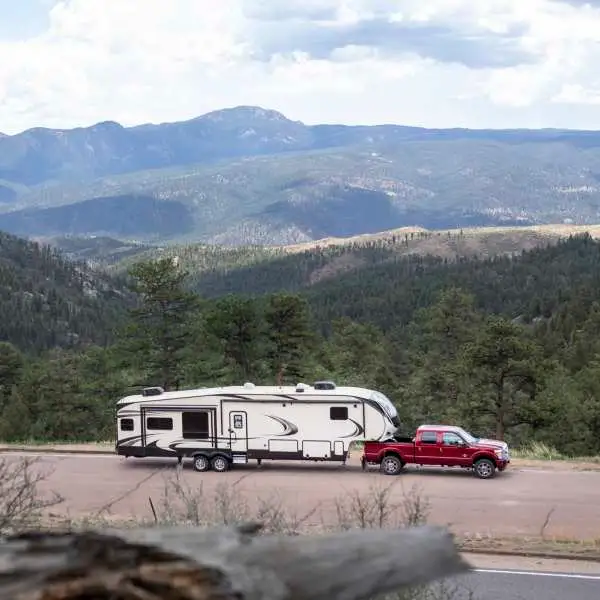



A-frame Trailer
The A-frame trailer, known also as the A-frame camper, is a camping trailer recognizable by it’s compact, A-shaped body when on the move. Once parked, these trailers have “pop-ups” that greatly extend your available living space.
This design makes for a notably lightweight RV trailer – typically between 2,500 to 3,600 pounds – that most trucks and SUVs can tow. They are also very short in length, ranging from 8 to 24 feet and only needing one or two axles.
Note, the A-frame can also refer to a trailer’s tongue, or the part of the trailer that connects the trailer’s body to the tow vehicle. In comparison to a straight tongue, which has a single beam, an A-frame tongue has two angled beams that provide more inherent stability due to the triangular shape that connects to the rest of the trailer’s frame.
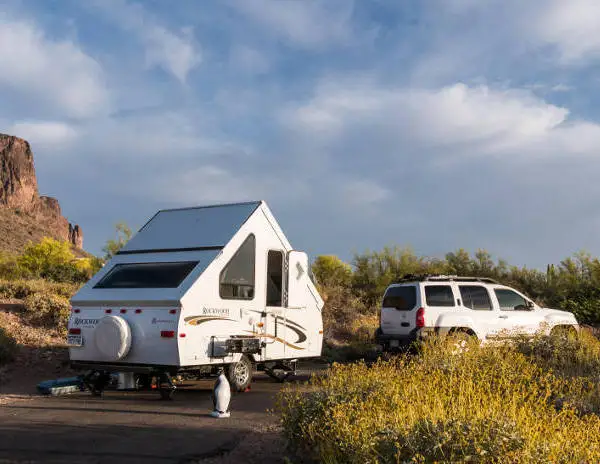



ATV Trailer
For those who spend much of their time outdoors, an ATV trailer may be a good investment. These small but sturdy trailers can be easily pulled behind all-terrain vehicles or four-wheelers. Accordingly, they are good off-road and often have a wagon-style design for keeping their contents in place.
ATV trailers tend to be on the smaller side – one to two axles, five to ten feet in length, and weighing between 125 to 1,500 pounds – perfect for an adventurer on the go!
Confusingly enough, an ATV trailer can also refer to trailers meant for hauling the ATVs themselves from place to place. These trailers are obviously bigger, weighing between 500 and 2,500 pounds and stretching between 10 and 16 feet in length.
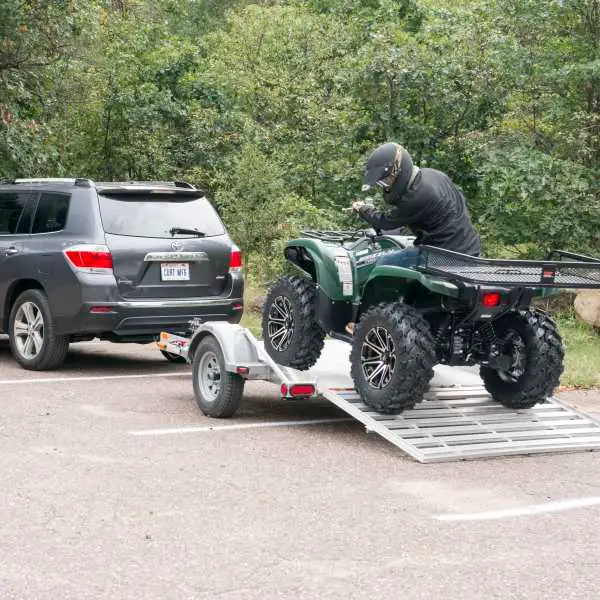



Boat Trailer
If a journey across the water sounds appealing – and you don’t store your craft on said water – you will likely need a boat trailer. These watercraft haulers come with components, typically rollers or bars, that you can adjust to securely support your boat.
Boats come in many different forms, from bass boats to pontoons to cabin cruisers. The sizes, shapes, and towing options of boat trailers vary greatly depending on what they’re built to tow. They can have one to three axles, stretch from 16 to 30 feet in length, and weigh anywhere between 900 and 34,000 pounds. While some can be safely towed by cars and minivans, others require heavier-duty SUVs and trucks.
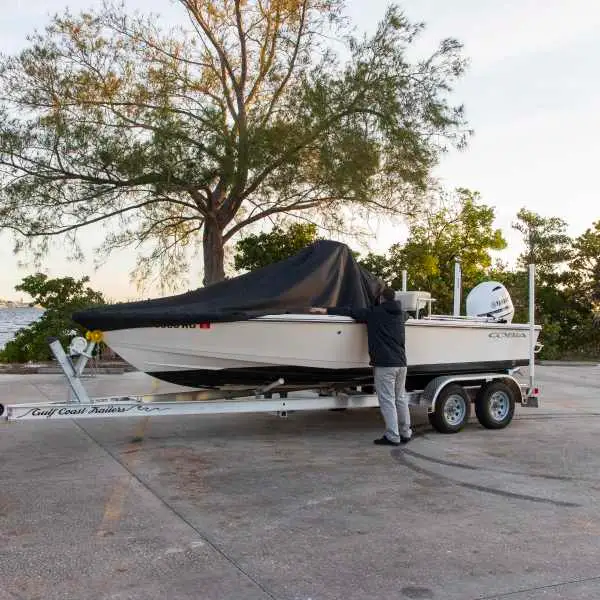



Bumper Pull Trailer
A bumper pull trailer is recognizable by how it is hitched to the tow vehicle. The trailer’s tongue ends with a spherical cup that can be placed over the ball hitch installed under the bumper of a tow vehicle, hence the name "bumper pull."
Given that most trailers that are not goosenecks or 5th wheels are bumper pulls, this leads to a lot of variation in purpose, size, and available tow vehicles. They can range between 125 to 20,000 pounds in weight and 5 to 40 feet in length. While the lighter ones can be towed by cars, the heavier ones need large trucks. It all depends on the individual trailer.
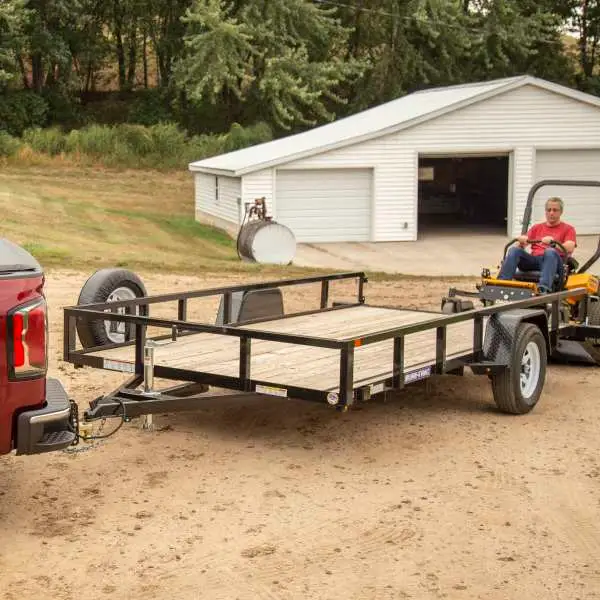



Canoe / Kayak Trailer
Want to practice your paddling? A canoe / kayak trailer is typically identifiable by the metal crossbars that can support multiple canoes, kayaks, and paddleboards. Enough for your whole family to enjoy!
These trailers are incredibly lightweight, usually having only one axle and weighing between 200 and 800 pounds, allowing most vehicles to tow them easily. They are generally 10 to 17 feet in length.
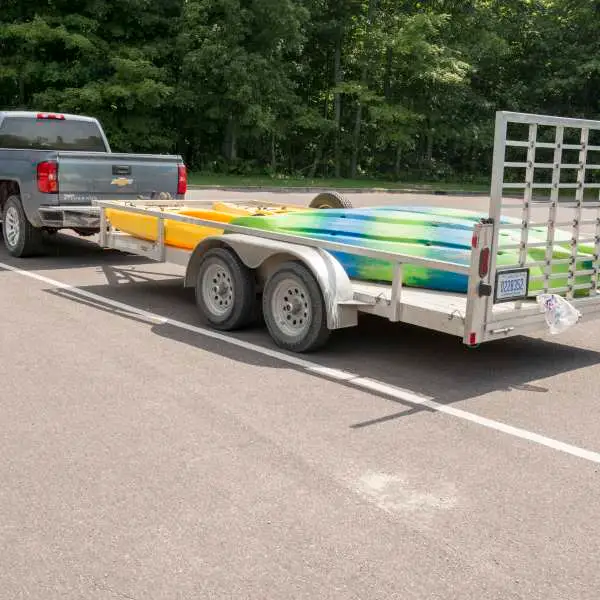



Car Trailer
Sometimes simply driving a car to get it somewhere isn’t the best option; this is where a car trailer comes in. With ramps at the back for rolling onto and a flat bed to park on, the car trailer was designed for hauling vehicles from point A to point B.
Since they are meant to carry a whole other vehicle, car trailers are only towable by large trucks. They weigh anywhere from 1,000 to 15,000 pounds and are 14 to 24 feet in length. They can have one to three axles.




Cargo Trailer
A cargo trailer is, as its name suggests, any trailer meant for hauling cargo. They often come equipped with walls and a roof in order to protect said cargo (see Enclosed Trailer).
They vary greatly in appearance, size, and tow vehicle options. They weigh between 2,700 and 7,000 pounds and stretch from 8 to 24 feet, requiring between one and three axles.
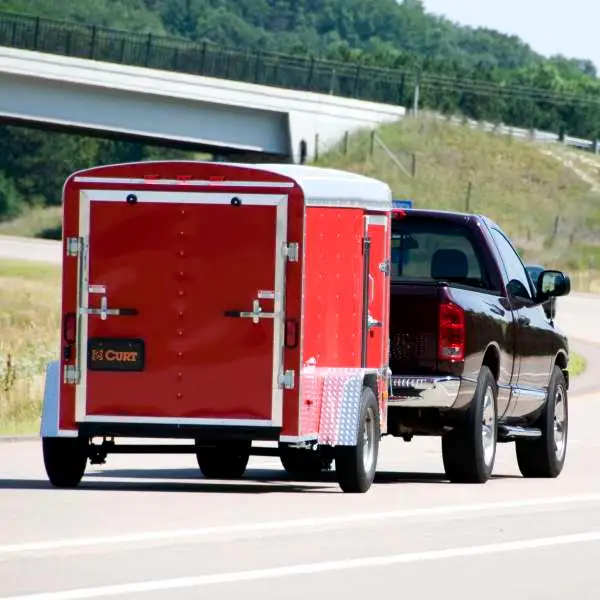



Construction Trailer
If you’ve ever passed by a construction site, you might have noticed a structure that resembled a small mobile home off to the side. These are construction trailers — portable office spaces used by construction teams. They are temperature-controlled and secure, offering workers a safe place to take breaks and store their equipment.
Construction trailers are fairly large by trailer standards, extending from 16 to 64 feet in length and weighing between 3,000 and 10,000 pounds, requiring heavy trucks to tow them. They typically have one to three axles.
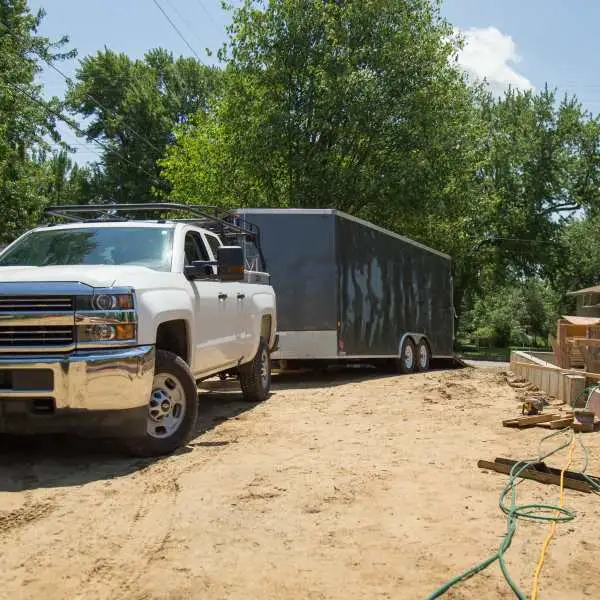



Dump Trailer
You won’t have to worry about manually unloading a dump trailer; these trailers have an open-topped box that can be tipped back to dump its contents. They are used to haul materials such as dirt, gravel, mulch, and so on.
Dump trailers tend to be heavy, needing one to four axles and heavy trucks to tow them. They weigh between 3,000 and 30,000 pounds and measure 8 to 30 feet in length.
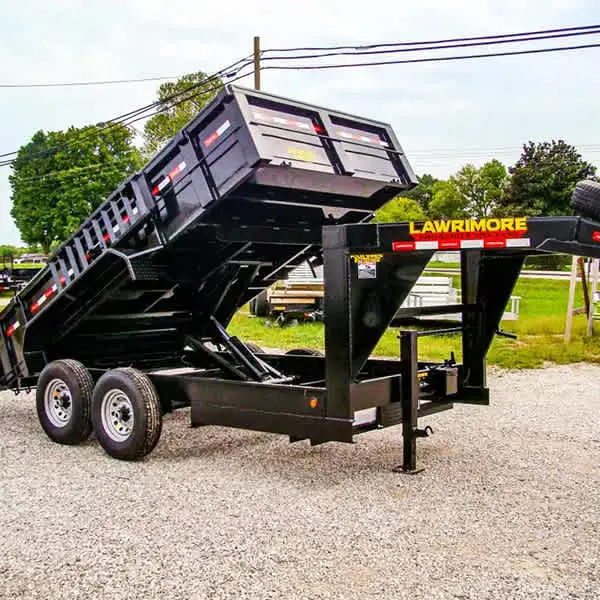



Enclosed Trailer
Enclosed trailers, also known as box trailers, are great for those who want a little extra protection for their cargo. Their bodies are completely enclosed by walls and a roof, preventing stealing and weather-related damage.
Enclosed trailers vary greatly in size, ranging between 2,000 and 10,000 pounds in weight and 8 to 32 feet in length. Cars and vans can tow lighter trailers, while heavier trailers need heavier-duty SUVs and trucks. They typically have one or two axles.
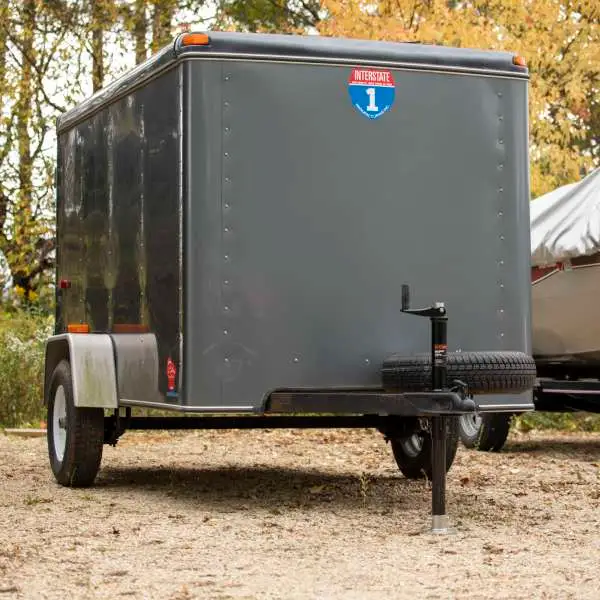



Equipment Trailer
If you need to transport heavier equipment or machinery, then an equipment trailer is just what you are looking for. Also known as equipment haulers, these trailers have ramps and flat beds excellent for loading and hauling cranes, excavators, et cetera.
Equipment trailers weigh anywhere between 1,000 to 10,000 pounds and can be 16 to 32 feet long, typically needing trucks and SUVs to tow them. They tend to have one to three axles.
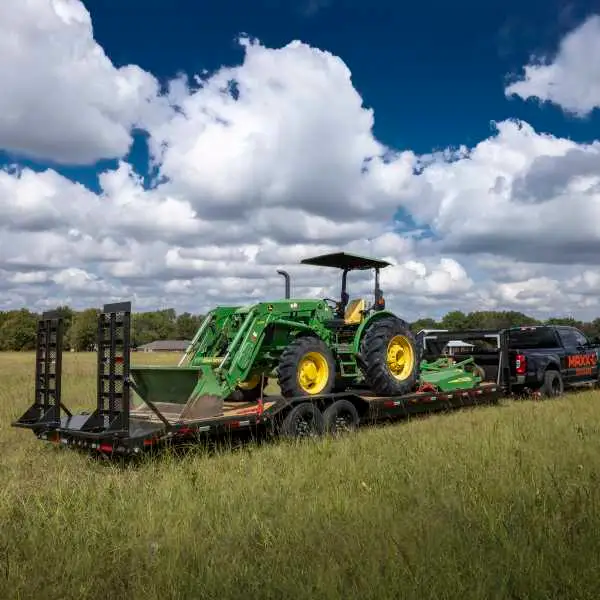



Flatbed Trailer
Also known as flat decks or deck-over trailers, flatbed trailers are known for their flat, open beds and lack of walls. This design choice allows them to haul particularly bulky pieces of equipment and supplies.
Flatbed trailers tend to be heavier – 2,900 to 26,000 pounds across one to three axles – and are usually towed by large trucks. They stretch between 48 and 53 feet in length.
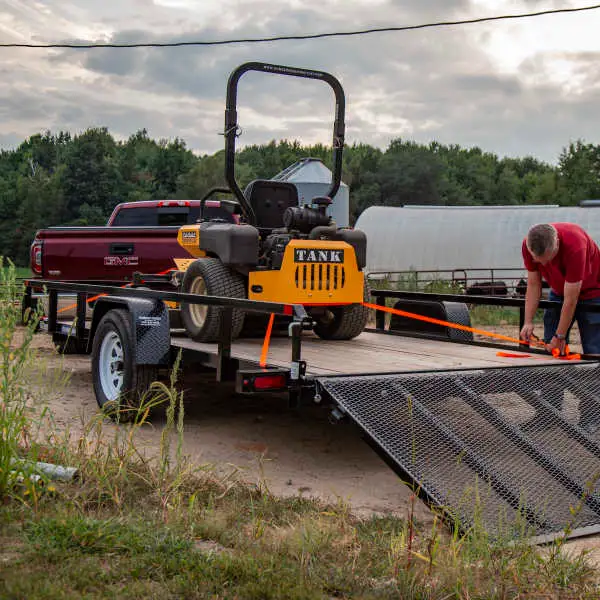



Food Concession Trailer
If you’ve ever gone to your local fair or community event, you’ve likely seen a whole forest of these! Food concession trailers are mobile kitchens and food stands, complete with a serving window to accept money and dish out food and beverages.
Food concession trailers weigh between 5,500 to 8,000 pounds and reach between 6 and 32 feet in length, typically only needing one or two axles. This allows them to be towed by trucks and, for the smaller ones, some SUVs.
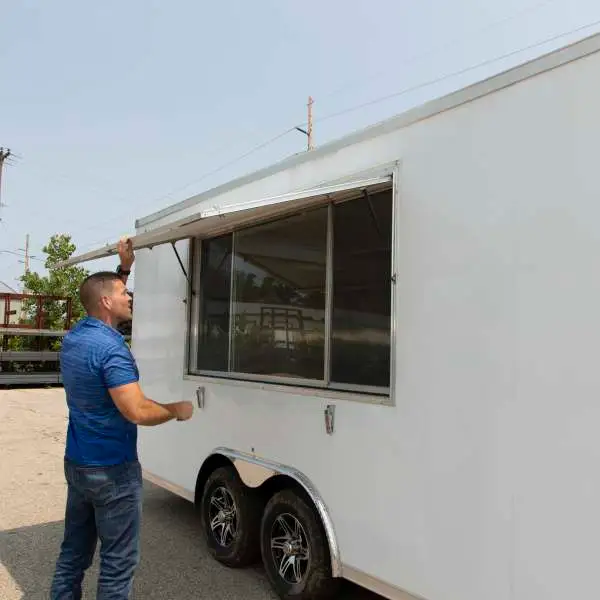



Full Trailer
A full trailer is unique due to having an axle at both the front and the back of the trailer, allowing for standalone support with no tongue weight. They are used by semi-trucks and tractors to haul farming or commercial goods.
Full trailers are some of the heaviest trailers out there, with two to four axles and weighing up to 33,000 pounds. They are generally 10 to 26 feet in length.




Gooseneck Trailer
Named for the unique shape of its nose / coupling mechanism, the gooseneck trailer is easily recognizable. The gooseneck coupler is designed to reach over the tow vehicle's tailgate and connect to a ball hitch installed in the tow vehicle’s bed. It offers similar stability to a 5th wheel trailer in that way, but the hitching equipment takes up far less space.
Pulled only by large trucks, gooseneck trailers are used to haul livestock, large pieces of equipment, and other materials. They tend to be very large as a result, possessing two or three axles, weighing 15,900 to 36,000 pounds, and reaching 20 to 40 feet in length.
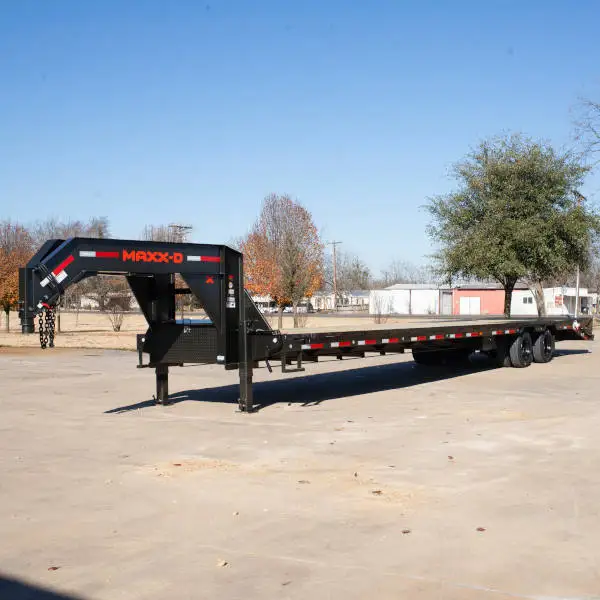



Gravity Box
Also known as a gravity wagon, the gravity box carries out an important role on many farms: holding and unloading crops or fertilizer. They get their name from how they utilize gravity – their slanted walls and a door near the bottom of the trailer make for easy unloading – far easier than emptying a trailer by hand!
Due to their size and typical location, gravity boxes are towed by large trucks or tractors. They weigh between 1,750 and 7,050 pounds and reach between 17 and 25 feet in length. They have at least two axles.




Horse Trailer
Horse trailers, as the name suggests, are used to transport horses and similarly large livestock. They come with several features to make your animal friends more comfortable on their journeys; an enclosed body with walls and a roof; windows or slots for increased ventilation; and better suspension to prevent injury on uneven terrain.
Horse trailers vary greatly in size and form, from small, steel-gray shuttles for a single horse to larger trailers that can hold not only multiple horses, but also small living spaces for their riders. While pickup trucks and SUVs may be able to tow smaller trailers, heavy-duty trucks are often needed for the larger ones. They reach 5,000 to 9,000 pounds in weight and 16 to 49 feet in length. They have two to three axles.
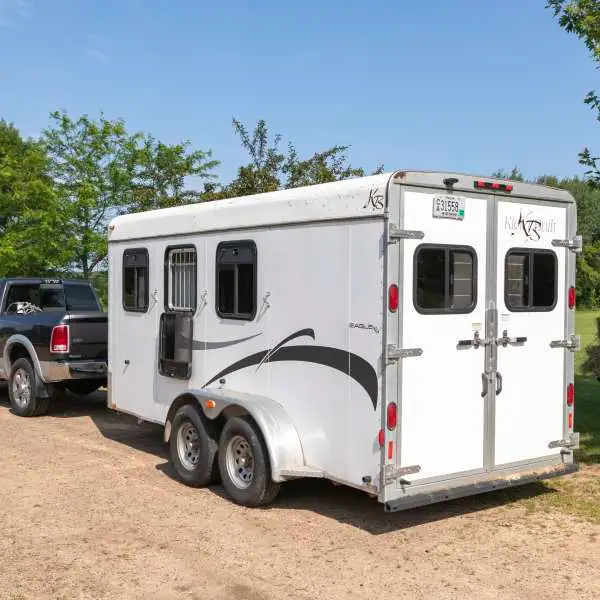



Jet Ski Trailer
For those looking for a ride as fun as it is wet, a jet ski trailer will be needed to haul your own personal watercraft. These trailers are similar to boat trailers in that they possess adjustable rolls or bars to support your craft on the go. Their compact design and lighter weight allow most vehicles to comfortably carry one or two jet skis at a time.
Jet ski trailers weigh between 800 and 3,000 pounds and reach between 12 and 34 feet in length. They can have one or two axles.




Landscape Trailer
If you want a little help ensuring that your property looks beautiful, a landscape trailer is a good tool to have. These trailers transport any tools or materials you need for landscaping. They have tall sides to securely hold equipment and a ramp for easy unloading.
Landscape trailers weigh between 1,000 to 3,000 pounds and extend between 8 and 24 feet in length. They tend to have one to two axles and, depending on the exact weight, can be towed by most vehicles – good news for both the amateur and professional landscapers out there!




Livestock Trailer
While most farm animals you see on road trips are standing in nearby fields, you might also spot some on the road beside you! Livestock trailers – sometimes called cattle trailers or stock trailers – haul cows, pigs, sheep, and other livestock animals from place to place. They are easily recognizable by their secure gates and the gaps cut into the walls for better ventilation.
Since they are meant to carry multiple large animals at a time, livestock trailers tend to be fairly large. They need two or three axles and can weigh anywhere from 9,000 to 24,000 pounds. They reach between 14 and 34 feet long. While the smaller livestock trailers can be towed by smaller pickup trucks and some SUVs, the larger ones require larger trucks.
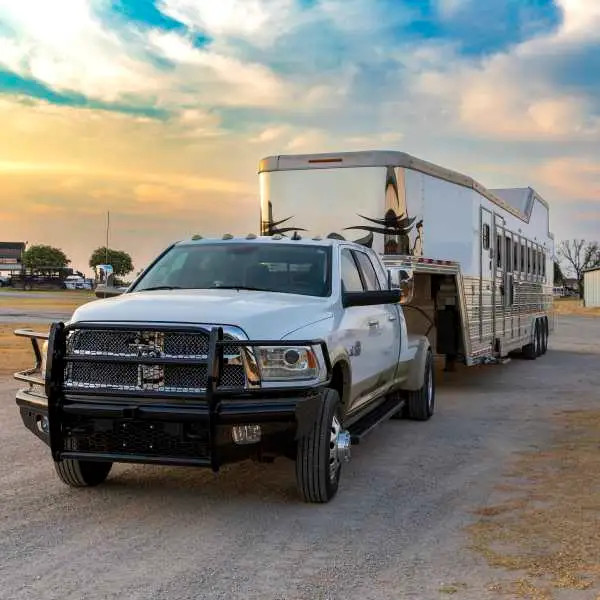



Lowboy Trailer
Lowboy trailers are specifically designed for hauling heavy-duty machinery. They are named for their extremely low decks, which sit below the trailers' tires and allow them to haul taller and bulkier items than most other trailers safely can, such as bulldozers or skid steers.
A common sub-type of lowboy trailers to make a note of is the removable gooseneck lowboy trailer, or RGN. These trailers, while typically having a shorter deck, possess a removable neck that makes it easier to load cargo onto the trailer.
Lowboy trailers are some of the biggest trailers out there. They can reach between 10,000 and 40,000 pounds in weight and 48 to 80 feet in length. They have three to five axles and require semi-trucks to tow them.




Motorcycle Trailer
While motorcycles can be fun to ride, you likely won't want to ride them everywhere. A motorcycle trailer can carry one or two of your favorite two-wheeled machines wherever you want to go. These trailers come with trays or brackets to securely hold the motorcycle’s wheels, ensuring the safety of your ride.
Motorcycle trailers are fairly light – 1,300 to 3,500 pounds – and can be towed by most vehicles. They have one to two axles and reach between 8 and 24 feet in length.
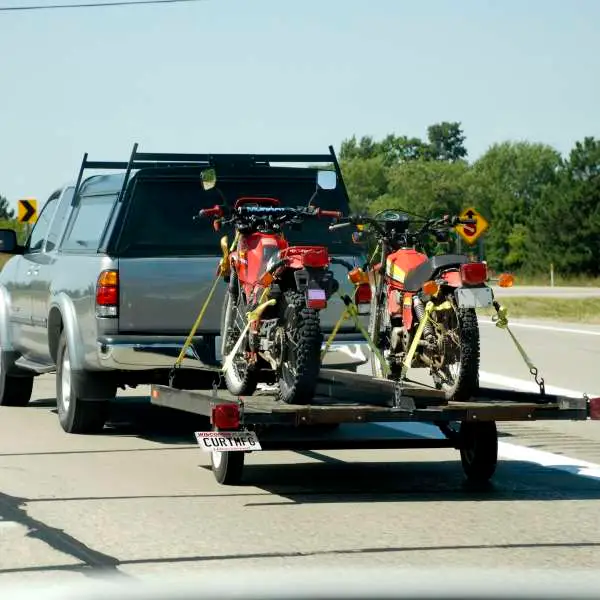



Open Trailer
An open trailer refers to any cargo trailer that has no roof and low or no walls. While they do offer less protection than their enclosed counterparts, open trailers do tend to be less expensive and more accessible.
The size of an open trailer can vary greatly, weighing between 1,000 to 10,000 pounds and reaching between 8 to 32 feet in length. Smaller open trailers can be towed by cars and vans, but larger ones require SUVs and trucks. They usually have one or two axles.
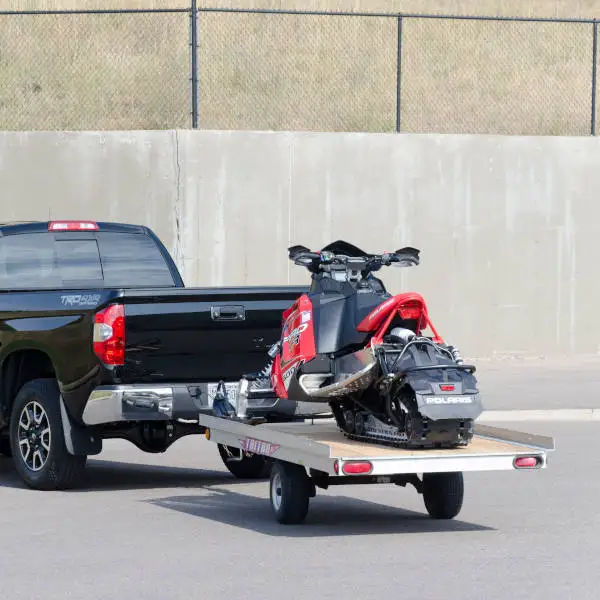



Popup Trailer
Want to go camping without bothering with a full-sized RV? Popup trailers – also known as popup campers or popup tent trailers – are named for their ability to be folded out once parked, offering a little home-away-from-home for small groups.
Similar to A-frame trailers, popup trailers are very lightweight by RV standards and can be towed by many vehicles. They only weigh between 2,700 and 4,000 pounds and reach between 8 and 24 feet in length. They typically only have one axle.
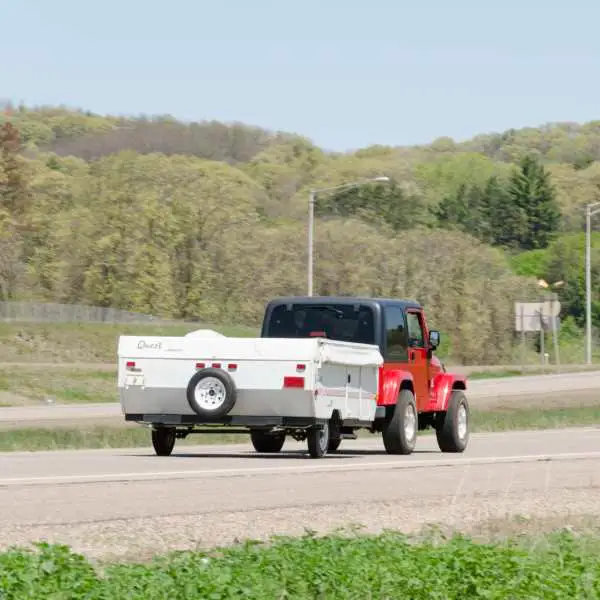



Recreational Vehicle Trailer
For those who love travel, camping, or living on the road, a recreational vehicle (RV) trailer can be the perfect portable home-away-from-home. There are many sub-types of RV trailers, such as 5th wheel trailers, travel trailers, toy haulers, teardrop trailers, and so on. All of them can be a good match for somebody!
RV trailers vary greatly in size: 1,900 to 22,500 pounds in weight, 15 to 48 feet in length, and one to four axles. Tow vehicle options depend largely on the individual trailer, so be sure to check your towing capacity!
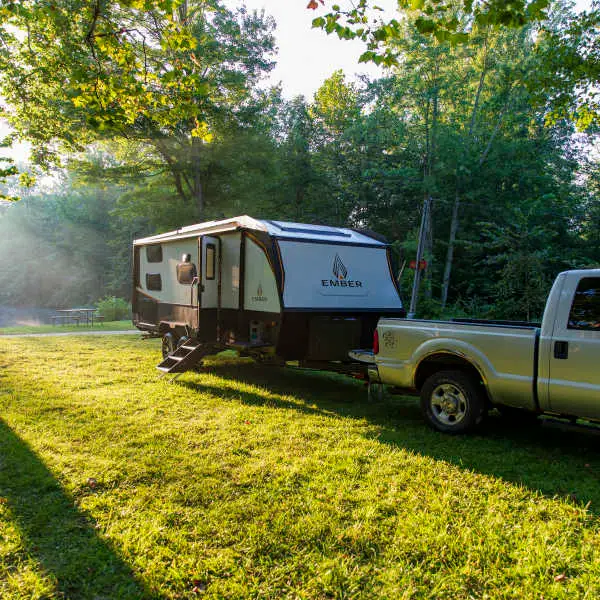



Refrigerated Trailer
You've heard of running refrigerators, but have you heard of rolling ones? Refrigerated trailers use their onboard refrigeration systems to haul cold food or materials without spoiling them.
Refrigerated trailers tend to weigh between 3,000 and 12,000 pounds, allowing a variety of tow vehicle options. They typically have one or two axles and reach between 7 to 16 feet in length.
However, there is a sub-type of refrigerated trailers known as reefers. Though they have the same general purpose, reefers are much bigger than other refrigerated trailers, requiring semi-trucks to tow them. They weigh 56,000 to 59,000 pounds, reach 28 to 48 feet in length, and have two to three axles.




Sailboat Trailer
Sailboat trailers can safely haul your sailboat to the sunny seas. As a type of boat trailer, they have adjustable rollers or bars to secure the craft in place.
Sailboat trailers are on the larger side for boat trailers, weighing between 8,000 and 11,000 pounds and needing large SUVs or heavy-duty trucks to tow them. They reach between 20 and 30 feet in length and have one to three axles.
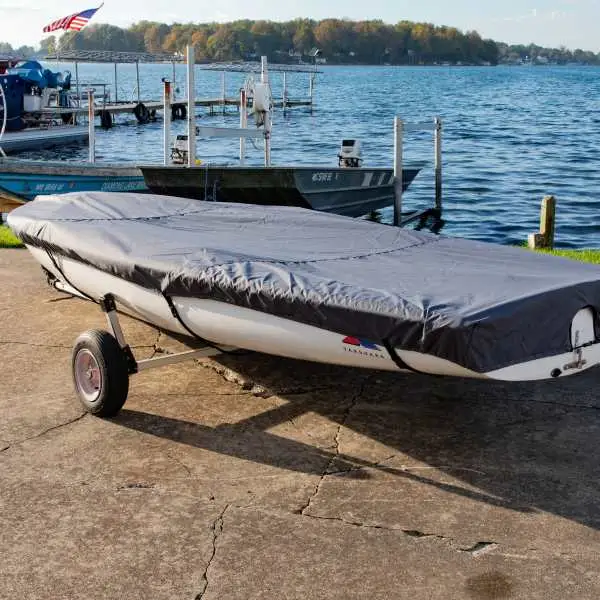



Semi Trailer
Used for large-scale hauling, semi trailers only have axles near the back, placing tongue weight on the tow vehicle unlike full trailers.
Semi trailers, as their name suggests, can only be towed by semi-trucks. For good reason; they weigh between 43,000 and 48,000 pounds and stretch between 48 and 53 feet in length. They can have two to four axles.
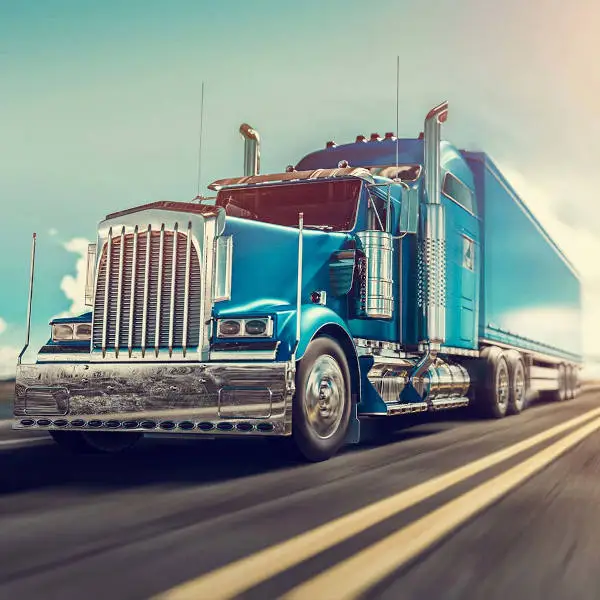



Silage Wagon
Also known as a forage wagon, chopper box, or forage box, the silage wagon is used for hauling silage, even possessing an open top to easily receive more. They also use a clevis pin-style coupler, which involves inserting a clevis pin through two holes in a U-shaped shackle.
Befitting their place on the farm, silage wagons are towed by tractors. They can weigh between 10,000 and 60,000 pounds and reach between 16 and 50 feet in length. They usually have two or three axles.




Single-Axle Trailer
As the name suggests, a single-axle trailer is any trailer with only one axle. Their shapes and purposes vary greatly, from single-axle dump trailers for hauling materials to single-axle travel trailers for camping. They can be anywhere from 5 to 20 feet in length.
With a weight range of 1,000 to 4,500 pounds, there is a great range of tow vehicle options for single-axle trailers too. Remember to check your vehicle’s towing capacity before you tow!
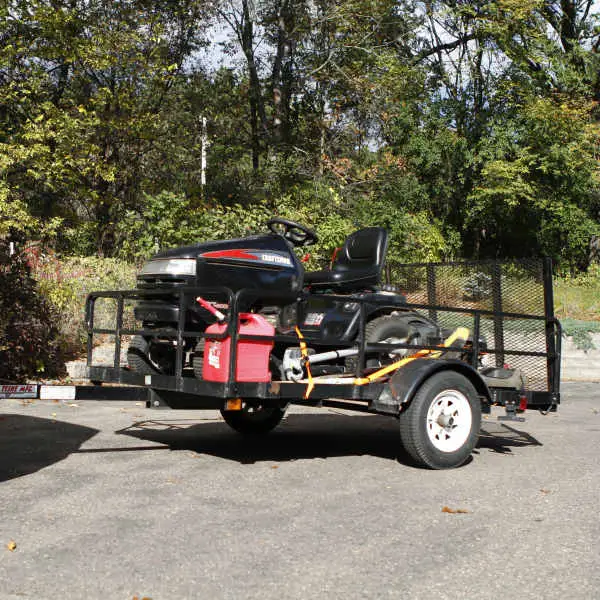



Snowmobile Trailer
For those of you who love speeding across the snow, a snowmobile trailer may prove a good investment. These trailers come with sturdy platforms and securing mechanisms for hauling one or more snowmobiles to your favorite cold-weather spots.
Snowmobile trailers weigh between 1,000 and 6,000 pounds, typically needing SUVs and trucks to tow them. They have one to two axles and reach between 12 and 30 feet in length.
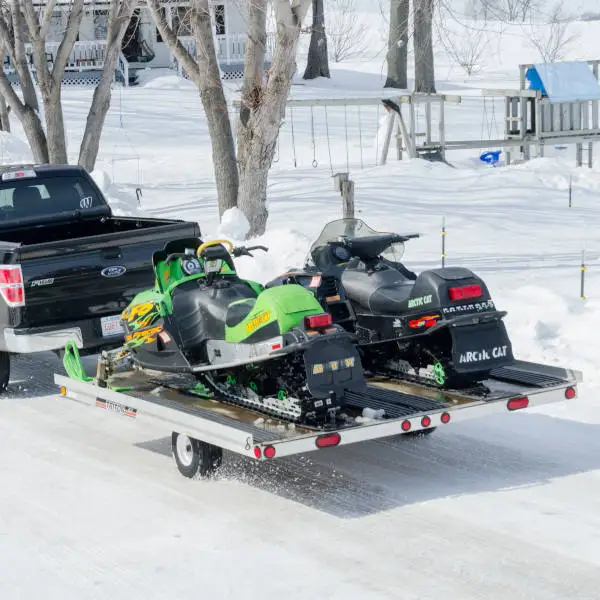



Step-Deck Trailer
Otherwise known as drop-deck trailers, step-deck trailers are easily spotted due to having two trailer beds – an upper one that is around 10 feet long and rests above the semi-truck’s back half, and a lower one that’s three times as long and much closer to the ground.
They are often compared to lowboy trailers due to being able to safely tow tall and bulky pieces of cargo, such as construction equipment. Although lowboys offer a little extra clearance for taller objects, step-deck trailers are a little more adaptable for different cargo types.
Step-deck trailers weigh between 43,000 and 48,000 pounds and can reach between 48 and 53 feet in length. They can only be pulled by semi-trucks and usually have two or three axles.




Tandem Axle Trailer
Otherwise known as the double-axle or dual-axle trailer, the tandem axle trailer has exactly two axles. Tandem means two, so hence two axles. Such trailers differ greatly in shape and purpose: flatbed utility trailers for hauling cargo, gooseneck trailers for transporting livestock, or travel trailers for camping are just a few examples.
The differences continue in terms of size and tow vehicle options. Tandem axle trailers weigh between 3,000 and 30,000 pounds and reach between 12 and 24 feet in length. Some of these trailers can be towed by cars or SUVs, while others need larger trucks.
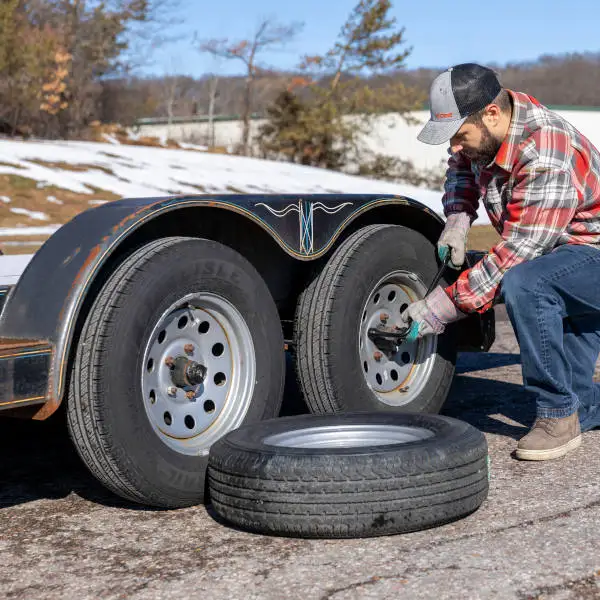



Teardrop Trailer
Teardrop trailers, also known as teardrop campers, are easily spotted for their compact, aerodynamic design. Resembling a sleek water droplet, these trailers are perfect for lone adventurers or couples wanting a cozy getaway.
Teardrop trailers are incredibly small by RV trailer standards, reaching only 2,000 to 4,000 pounds in weight and 5 to 12 feet in length. They can be towed by most vehicles and almost always have only one axle.
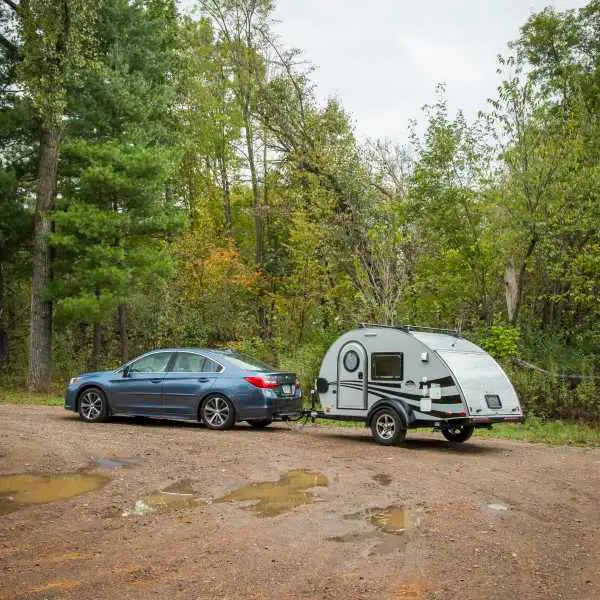



Toy Hauler
Having a home-away-from-home is nice, but have you ever thought about having a garage-away-from-garage? Toy haulers are a type of RV trailer that come with not only a living space, but a small garage for recreational vehicles — perfect if you want to bring your ATV or canoe on your camping trip!
Toy haulers are some of the biggest RV trailers out there, and as such, can only be safely towed by trucks. Their weight ranges between 14,000 and 23,000 pounds, while their length can be 15 to 48 feet. They usually have two or three axles.
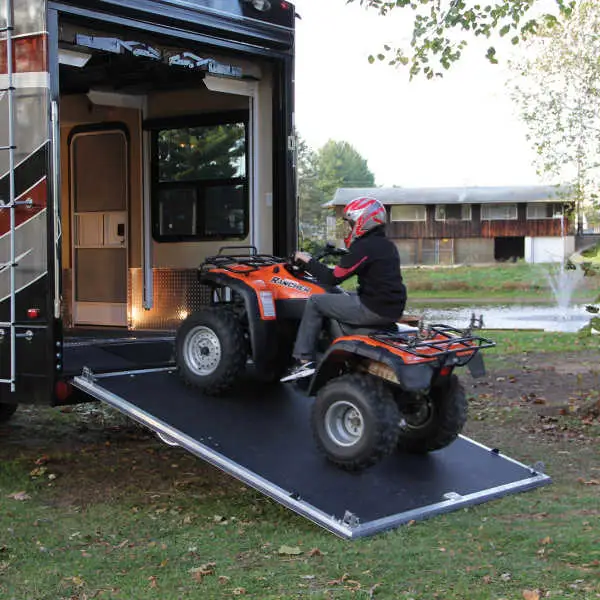



Travel Trailer
Arguably the most well-known type of RV trailer, travel trailers are portable living spaces that are hitched to the tow vehicle via a receiver hitch, rather than a 5th wheel hitch. Many campers and cross-country tourers have made wonderful memories in travel trailers.
Travel trailers are 1,900 to 10,500 pounds in weight and 15 to 40 feet in length. While they are typically towed by trucks or SUVs, some of the smaller ones may have more options for tow vehicles. They usually have one to two axles.
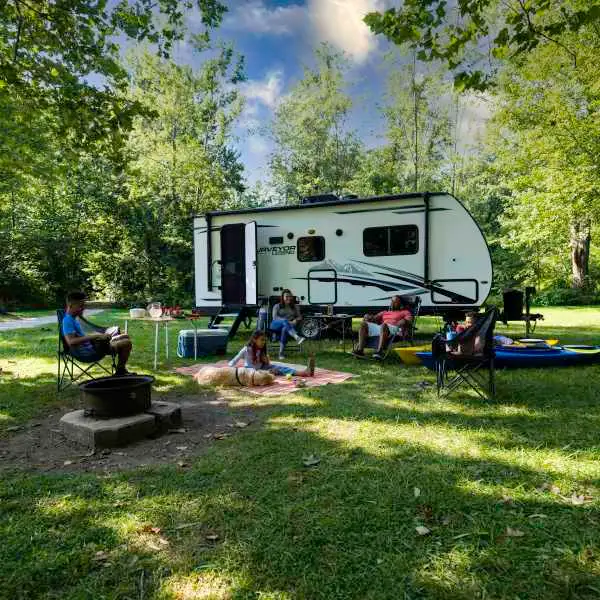



Tri-Axle Trailer
As their name suggests, tri-axle trailers are trailers with three axles. These are usually some of the biggest trailers out there, such as flatbeds, goosenecks, or large dump trailers.
Tri-axle trailers typically weigh between 10,000 and 30,000 pounds and reach between 20 to 53 feet in length. Their greater size means they are normally towed by pickups or even semi-trucks.
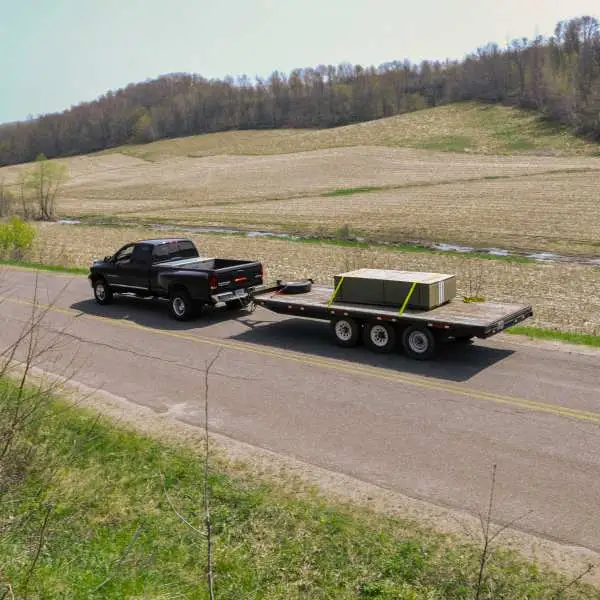



Utility Trailer
Utility trailers are excellent at hauling materials, supplies, and other such cargo. They are identifiable by their flat decks and ramps meant for easy loading and unloading.
Utility trailers weigh between 1,000 and 10,000 pounds, reach between 8 and 22 feet in length, and have one to two axles. Most vehicles are capable of towing at least some of these handy little trailers.
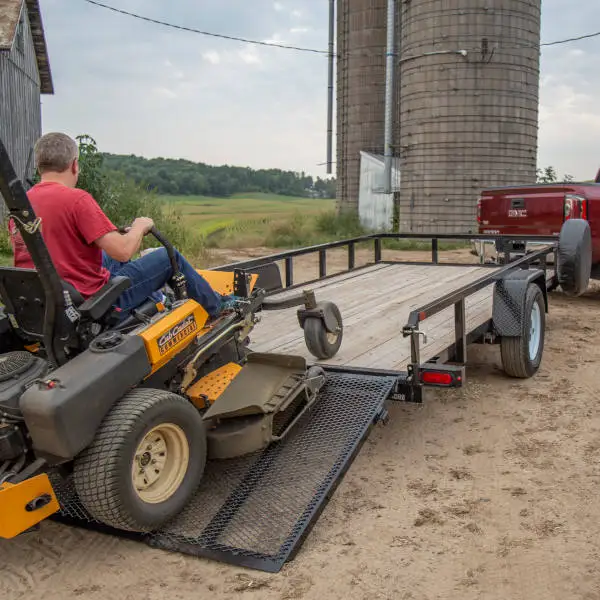

Trailer Type FAQs
- How many types of trailers are there?
The simple answer: loads! As our guide has shown you, there are many types and sub-types of trailers, and they frequently overlap with each other. Finding the perfect trailer for you will likely take time, but understanding some of the basic trailer types can certainly help! - What is the difference between a 5th wheel trailer and a travel trailer?
5th wheel trailers are bigger, have more luxuries, and tow more steadily on the road; however, they require 5th wheel hitches and pick-up trucks to tow them and are usually more expensive. Travel trailers are less expensive, offer more tow vehicle options, and handle off-road adventures better, but they are smaller and offer fewer luxuries. That said, they are both perfectly good RV trailer options. - Which is better, a gooseneck trailer or a bumper-pull trailer?
There are distinct pros and cons for both gooseneck and bumper-pull trailers. Gooseneck trailers offer more space and stability, but they cost more and need a pickup truck to tow them due to their hitching equipment. Bumper-pull trailers are generally cheaper and have more tow vehicle options, but are smaller and more prone to swaying, which may require you to get a weight distribution system to tow safely. Which trailer is best for you depends on your needs and available vehicles.
Disclaimer: These photographs, recommendations, and approximations are intended for demonstration purposes only and do not reflect the specifications of any particular tow vehicle, recreational vehicle, or trailer. Always consult the manufacturer’s Owner's Manual.
 ARIES
ARIES  CURT
CURT  LUVERNE
LUVERNE  UWS
UWS 


